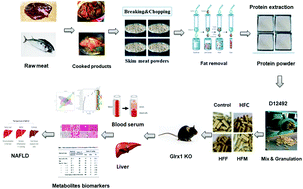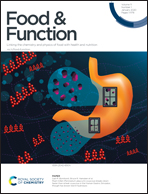High fat diet incorporated with meat proteins changes biomarkers of lipid metabolism, antioxidant activities, and the serum metabolomic profile in Glrx1−/− mice†
Abstract
Red and processed meat consumption has been associated with oxidative stress, diabetes and non-alcoholic fatty liver disease (NAFLD). This study was aimed at exploring the effects of high-fat meat protein diets on potential metabolite biomarkers in Glrx1−/− mice, a well-documented mouse model to study NAFLD. Male Glrx1−/− mice were fed a control diet with 12% energy (kcal) from fat, a high-fat diet supplemented with casein (HFC) with 60% energy (kcal) from fat, and a high-fat diet supplemented with fish (HFF) or mutton proteins (HFM) for 12 weeks. The results of biochemical and histological analyses indicated that the intake of HFM increased hepatic total cholesterol, triglycerides, serum alanine transaminase and aspartate transaminase, and macro- and micro-vesicular lipid droplet accumulation, which were accompanied by altered gene expression associated with the lipid and cholesterol metabolism. HFF diet fed Glrx1−/− mice significantly ameliorated diet-induced NAFLD biomarkers compared to HFC and HFM diets. In addition, serum metabolome profiling identified metabolites specifically associated with lipid metabolism bile acid metabolism, sphingolipid and amino acid metabolism pathways. A HFM diet increased the abundance of LysoPC(15:0), LysoPC(16:0), LysoPC(20:1), LysoPE(18:2), LysoPE(22:0), LysoPE(20:6), O-arachidonoylglycidol, 12-ketodeoxycholic acid and sphinganine that are associated with NAFLD. The KEGG metabolic pathway of identified metabolites of high fat diets showed that the differential metabolites were associated with lipid metabolism, linoleic acid metabolism, amino acid metabolism, bile acid metabolism, sphingolipid metabolism, and glutathione metabolism pathways whereas HFF diet ameliorated NAFLD by modifying these pathways. These results provide potential metabolite biomarkers for NAFLD induced by HFM diet.

- This article is part of the themed collection: Food & Function Recent HOT articles


 Please wait while we load your content...
Please wait while we load your content...